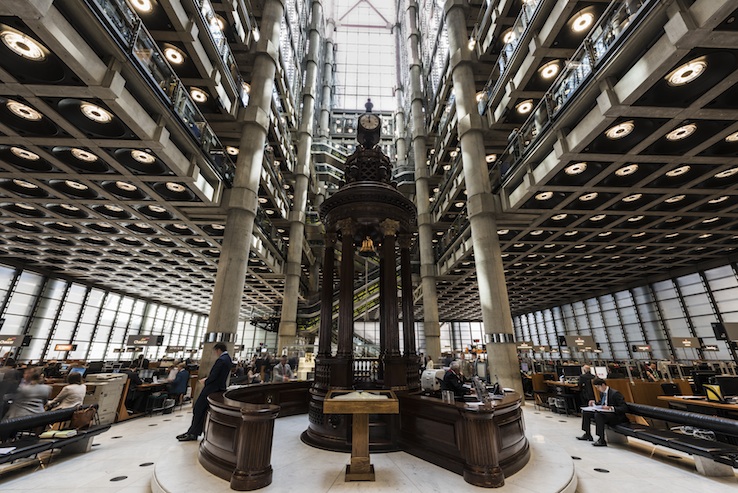This past July, National Underwriter Property & Casualty's Editor-in-Chief Shawn Moynihan and Associate Online Features Editor Caterina Pontoriero traveled to the storied Lloyd's of London for an exclusive tour of the market's building and inner workings.
We went with one simple goal: To give insurance professionals an inside look at what Lloyd's of London really is and what it does.
On our trip, NU P&C took exclusive photos and videos from inside the stunning Lloyd's building (pictured above at night), as well as an interview with Lloyd's Chairman John Nelson. We also sat down with representatives from Lloyd's syndicate Barbican Insurance Group and Aon Benfield to discuss the advantages of working in the Lloyd's market and learn how a reinsurance risk is placed.

Lloyd's Chairman John Nelson sat down for a video interview with NU P&C Editor-in-Chief Shawn Moynihan. Watch Part 1 of our look inside Lloyd's with Nelson “Inside Lloyd's: John Nelson and the Lloyd's Building,” and see our first video with Nelson on the impact of the Brexit referendum on the Lloyd's market: “John Nelson on how Brexit will impact Lloyd's of London.” (Photo: Ben Pipe)

Clive Butcher of Aon Benfield, and Ondine Bourrut Lacouture of Barbican Insurance Group, walked NU P&C through the placing of a reinsurance risk at Lloyd's of London. Watch Part 2 of our look inside Lloyd's with Butcher and Lacouture “Inside Lloyd's: Writing a reinsurance risk at Lloyd's of London.” (Photo: Ben Pipe)
What is Lloyd's of London?
An important distinction to make about Lloyd's of London is that it is not an insurance company; it is an insurance market.
Its syndicates (market-member insurance carriers underwriting coverage under the watch of managing agents) tackle some of the world's most specialized risks, offering a wide spectrum of solutions.
Lloyd's offers diversity in terms of specialty when assessing nontraditional risks. While many often invoke it in conversation as “the place where Mariah Carey had her legs insured,” the truth is, the majority of risks insured at Lloyd's are far more vital to national economies, even if often a bit less glamorous.
A global hub for specialist insurance and reinsurance, Lloyd's enables U.S. brokers to access underwriting talent and insurance coverage for a variety of Property & Casualty classes.

At the heart of the main underwriting floor inside Lloyd's is the Lutine Bell and the fabled Loss Book. (Photo: Ben Pipe)
Intersection of past and present
Lloyd's started more than 300 years ago in Edward Lloyd's Coffee House on Tower Street, where it built a reputation as having the best intelligence on shipping. By the early 1700s, it became the go-to place for Marine insurance. More than three centuries later, a visit to its London office at 1 Lime St. finds this global specialist insurance and reinsurance hub abuzz with activity as brokers and underwriters negotiate coverage.
Natural light streams in from all directions from its towering central atrium, where criss-crossing escalators carry some of the world's top insurance talent from one floor to the next. On its main underwriting floor opposite the Lutine Bell rests Lloyd's fabled Loss Book, in which major losses are still recorded as they have been for centuries — with a feather quill pen.
Insurance requests from the United States come to Lloyd's through brokers, managing general agents, coverholders (firms that are given delegated authority by Lloyd's underwriters to write business on a discretionary basis) and other intermediaries. Lloyd's underwriters insure nearly every class of business in the U.S., with the exception of Workers' Compensation, Life and financial guarantees; its underwriters are authorized surplus lines insurers in all 50 states.
More than 40 percent of Lloyd's global premiums are held by U.S. customers, primarily surplus lines insurance (including Marine, Energy and Aviation) and reinsurance. In 2015, the market's gross written premiums topped £26.7 billion (about $34.6 billion). U.S.-dollar-denominated business accounts for the largest share of business at Lloyd's.

The Lloyd's Loss Book, in which major shipping losses are recorded as they have been for centuries, with a feather quill pen. (Photo: Ben Pipe)

The feather quill pen and ink used to record major shipping losses in the Lloyd's Loss Book. (Photo: Ben Pipe)

Each syndicate in the Lloyd's market has its own box where business is conducted face to face. (Photo: Ben Pipe)
Face-to-face risk negotiation
The majority of business written at Lloyd's is placed through brokers, who expedite the transfer of risk between policyholders and underwriters.
A great deal of the coverage placed at Lloyd's is negotiated face-to-face in the underwriting room. Each syndicate has its own “box” where business is transacted between brokers and the syndicate's underwriters.
Brokers also may access the Lloyd's market through coverholders or service companies.
Video: John Nelson on how Brexit will impact Lloyd's of London

A total of 40.5 percent of Lloyd's global premium comes from the United States. Total U.S. premium in 2015 grew 3 percent to $15.1 billion.
Global reach
While the Lloyd's building is in London, its reach extends far beyond the United Kingdom. Its international market provides insurance to more than 200 countries and territories.
Its insurance licenses in more than 75 jurisdictions, bolstered by a network of local offices and coverholders across the globe, allow access to insurance markets of any size.

Lloyd's syndicates and brokers meet in person at the box on the main underwriting floor. (Photo: Ben Pipe)

A breakdown of Lloyd's U.S. classes of business.

The Lloyd's building, designed by British architect Richard Rogers, illuminated at night. (Photo: Ben Pipe)
Architectural wonder
Designed by British architect Richard Rogers, the Lloyd's building took eight years to build and used 33,510 cubic meters of concrete, 30,000 square meters of stainless steel cladding and 12,000 meters of glass. Its space-age facade towers above many of its City of London neighbors in this densely built-up section of town.
Although paid tours of Lloyd's are conducted, they are restricted to insurance business-related groups and to university or business school students. A dress-code tip for those lucky enough to schedule a visit: It's strictly suits or jackets, trousers and ties for men, and smart business style for women.

The Lloyd's building during working hours. (Photo: Ben Pipe)

The Lloyd's building's atrium fills the underwriting floors with natural light. (Photo: Ben Pipe)

Escalators in the center of the building carry visitors and employees to the various underwriting floors within the building. (Photo: Ben Pipe)

The Lutine Bell was recovered by Admiral Nelson in the Battle of Trafalgar and is now an integral part of Lloyd's history. It is rung to comemorate happy events such as the birth of a new heir to the throne as well as to pay tribute during tragic events, such as terrorist attacks. (Photo: Ben Pipe)
Two for good luck
Lloyd's is home to the Lutine Bell, which was recovered from the sunken British frigate HMS Lutine. The bell is rung only to mark events of great significance, with one stroke to signify bad news (for example, on 9/11) and two strokes to mark a positive event (for instance, when Queen Elizabeth II her husband, Prince Philip, visited the market in March 2014 to unveil a plaque commemorating Lloyd's 325th anniversary).
Video: Learn more about the Lutine Bell and Lloyd's Loss Book

A glass case on the main underwriting floor is filled with the Nelson Collection, a display of artifacts from Lloyd's of London's rich history spanning hundreds of years. (Photo: Ben Pipe)
Saluting its origins
The Lloyd's building is also home to the Nelson Collection, a display of prized historical objects that honor Vice Admiral Horatio Nelson (a flag officer in the Royal Navy who won many decisive victories at sea) and serve as a reminder of its origins in maritime insurance.
This permanent exhibit contains such treasures as vases awarded by the Patriotic Fund at Lloyd's in 1808 and 1809 to heroes of the Royal Navy; a detailed model of the HMS Victory, Vice Admiral Lord Nelson's flagship at the Battle of Trafalgar, a key victory for the Royal Navy against the combined fleets of the French and Spanish Navies in 1805; and illustrations depicting Nelson's funeral procession (below), which culminated in his internment in the crypt of St. Paul's Cathedral.
Video: How Admiral Nelson recovered the Lutine Bell and made it an integral part of Lloyd's history

Illustrations depicting Vice Admiral Horatio Nelson's funeral, part of the Nelson Collection at the Lloyd's building. The Collection is a display of prized historical objects that honor Admiral Nelson and serve as a constant reminder of Lloyd's origins in maritime insurance. (Photo: Ben Pipe)

Ondine Bourrut Lacouture of Barbican Insurance Group puts her scratch and stamp of approval on a reinsurance risk.(Photo: Ben Pipe)
A good scratch
When Lloyd's underwriters receive underwriting authority, they register what is called their “scratch,” or their signature, which has legal force when issues of coverage approval are at stake.
Video: Putting a scratch and stamp of approval on a reinsurance risk
Want to continue reading?
Become a Free PropertyCasualty360 Digital Reader
Your access to unlimited PropertyCasualty360 content isn’t changing.
Once you are an ALM digital member, you’ll receive:
- Breaking insurance news and analysis, on-site and via our newsletters and custom alerts
- Weekly Insurance Speak podcast featuring exclusive interviews with industry leaders
- Educational webcasts, white papers, and ebooks from industry thought leaders
- Critical converage of the employee benefits and financial advisory markets on our other ALM sites, BenefitsPRO and ThinkAdvisor
Already have an account? Sign In Now
© 2025 ALM Global, LLC, All Rights Reserved. Request academic re-use from www.copyright.com. All other uses, submit a request to [email protected]. For more information visit Asset & Logo Licensing.








